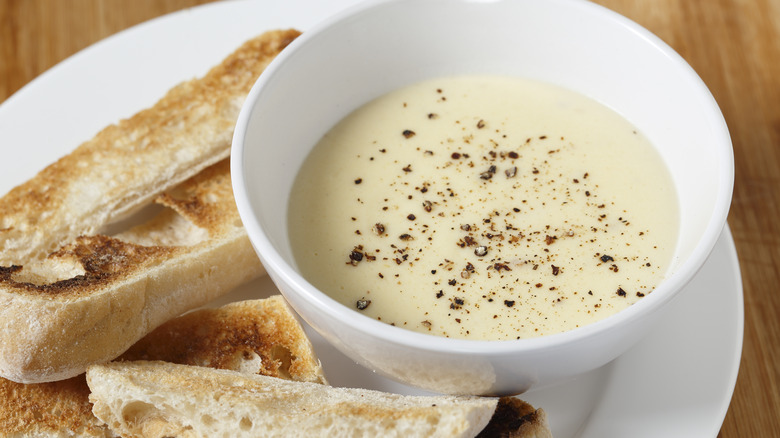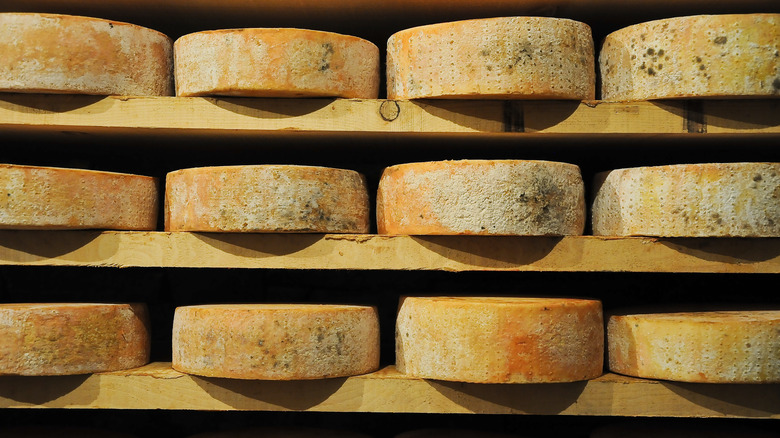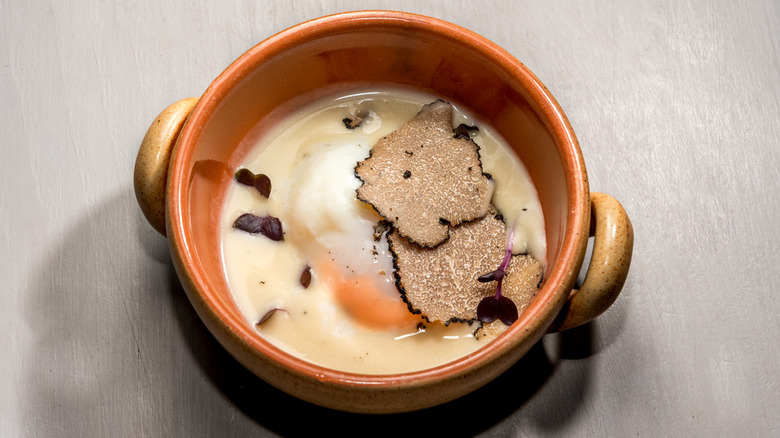Fontina Cheese Is The Star Ingredient In This Thick Italian Soup
In the mountainous region of Northern Italy lies the Valle d'Aosta or the Aosta Valley, a tiny section bordered by France, Switzerland, and the Piedmont region of Italy. In this alpine area, you won't find standard verdant Italian fare, rich with tomatoes, herbs, and vegetables. Instead, this cold locale celebrates the hearty side of cuisine, reveling in cheese, butter, bread, meat, and nuts. Of all the decadent meals that have come from this picturesque region, none commands as much love as Fonduta alla Valdostana, a hot liquid cheese recipe that is served simply with bits of earthy, toasted rye bread.
Call it cheese dip or cheese soup, but no matter what name you use, this Italian version of fondue is powered by fontina cheese rather than Swiss. Fontina is perhaps the Aosta Valley's most famous export, so it's no surprise that it takes center stage in this cheesy comfort food. But how did this warming local dish come to be?
The history of Fonduta alla Valdostana
The story of Fonduta alla Valdostana begins with the origin story of its base cheese, fontina. Records for fontina date all the way back to the 1200s, and the people of the Aosta Valley have been making it for generations. The Aosta Valley's unique dairy cows, Valdaostan Red Spotted Cows, have access to the green pastures of the Alps, creating milk with superior richness. From this dairy comes the lovely fontina, which is aged for three months at minimum as jumbo wheels of cheese, usually measuring 18 inches across and weighing up to 22 pounds. Young fontina is described as creamy and buttery, while older fontina can taste drier and sharper. In general, this cheese is noted for its versatile yet nutty and rich flavor.
When did the Italians begin turning fontina into fonduta? Fondue itself has mysterious origins but many believe it began in Switzerland in the 1800s. From there it traveled to the Alpine region of Italy, where the locals opted to use their own cheese of choice, fontina, instead of the ubiquitous Swiss. In addition to that, the people of the Aosta Valley have never used alcohol, garlic, or cornstarch in their fonduta recipes. Instead, it's blended with butter and milk while eggs work as the thickener, making this mixture particularly custardy. Finally, fonduta is more simply served with just toasted bread and/or fried pieces of polenta, although the odd vegetable and pickle can occasionally be used as well.
How to make your own fonduta
To make your own version of fonduta, begin with selecting a proper wedge of fontina. Note that many of the fontina cheeses you'll find at the grocery stores are technically not authentic, as the cheese must be made in Aosta Valley to be considered such (often labeled Fontina Val d'Aosta DOP). Still, if you can't locate the real stuff, most faux fontina (also known as fontel or fontella) will work to mimic the desired flavor and texture.
Next, you'll want to melt the cubed fontina with milk (1 cup of milk for every 10 ounces of cheese). Use a double boiler for the best melting results. Once everything is evenly melted and mixed together, make sure that your temperature is low, as you'll be adding the eggs next. Most recipes call for two or four egg yolks, adding them in one at a time and thoroughly mixing with a whisk. You'll continue to gently heat your fonduta until it becomes considerably glossy, a further 10 minutes. One final signature touch direct from Northern Italy is to add a dash of white truffle oil or, if you can swing it, freshly shaved white truffles on top. After that, you'll merely want some toasted bread and a good friend with whom to share this ample cheesy feast.


